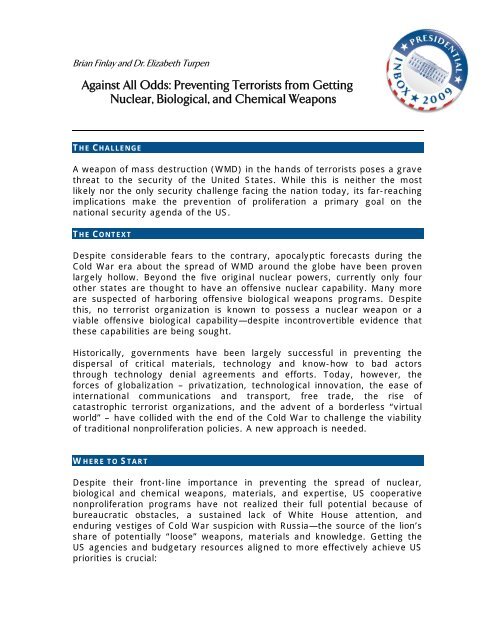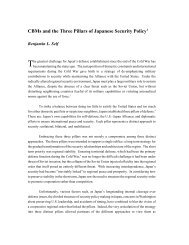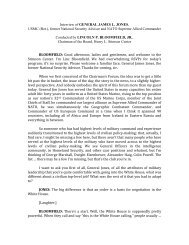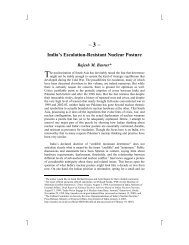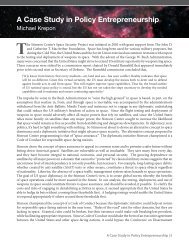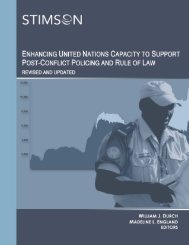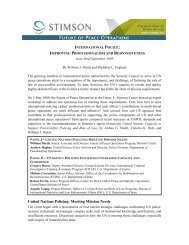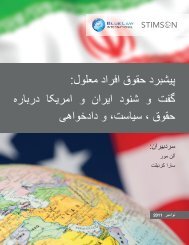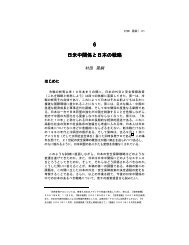Against All Odds: Preventing Terrorists from Getting Nuclear ...
Against All Odds: Preventing Terrorists from Getting Nuclear ...
Against All Odds: Preventing Terrorists from Getting Nuclear ...
Create successful ePaper yourself
Turn your PDF publications into a flip-book with our unique Google optimized e-Paper software.
Brian Finlay and Dr. Elizabeth Turpen<br />
<strong>Against</strong> <strong>All</strong> <strong>Odds</strong>: <strong>Preventing</strong> <strong>Terrorists</strong> <strong>from</strong> <strong>Getting</strong><br />
<strong>Nuclear</strong>, Biological, and Chemical Weapons<br />
THE CHALLENGE<br />
A weapon of mass destruction (WMD) in the hands of terrorists poses a grave<br />
threat to the security of the United States. While this is neither the most<br />
likely nor the only security challenge facing the nation today, its far-reaching<br />
implications make the prevention of proliferation a primary goal on the<br />
national security agenda of the US.<br />
THE CONTEXT<br />
Despite considerable fears to the contrary, apocalyptic forecasts during the<br />
Cold War era about the spread of WMD around the globe have been proven<br />
largely hollow. Beyond the five original nuclear powers, currently only four<br />
other states are thought to have an offensive nuclear capability. Many more<br />
are suspected of harboring offensive biological weapons programs. Despite<br />
this, no terrorist organization is known to possess a nuclear weapon or a<br />
viable offensive biological capability—despite incontrovertible evidence that<br />
these capabilities are being sought.<br />
Historically, governments have been largely successful in preventing the<br />
dispersal of critical materials, technology and know-how to bad actors<br />
through technology denial agreements and efforts. Today, however, the<br />
forces of globalization – privatization, technological innovation, the ease of<br />
international communications and transport, free trade, the rise of<br />
catastrophic terrorist organizations, and the advent of a borderless “virtual<br />
world” – have collided with the end of the Cold War to challenge the viability<br />
of traditional nonproliferation policies. A new approach is needed.<br />
WHERE TO START<br />
Despite their front-line importance in preventing the spread of nuclear,<br />
biological and chemical weapons, materials, and expertise, US cooperative<br />
nonproliferation programs have not realized their full potential because of<br />
bureaucratic obstacles, a sustained lack of White House attention, and<br />
enduring vestiges of Cold War suspicion with Russia—the source of the lion’s<br />
share of potentially “loose” weapons, materials and knowledge. <strong>Getting</strong> the<br />
US agencies and budgetary resources aligned to more effectively achieve US<br />
priorities is crucial:
Spearhead a global reassessment of proliferation threats and program objectives with<br />
the intent to achieve specific priorities more quickly and cost effectively<br />
The president should appoint a single, high-level National Security<br />
Council official to coordinate a comprehensive interagency<br />
reassessment of global proliferation threats and government-wide<br />
program responses.<br />
The original cooperative nonproliferation programs were conceived and<br />
launched in the early years following the unanticipated collapse of the<br />
Soviet Union. Despite radically different circumstances in Russia and<br />
the other former Soviet states today, and a dramatically different<br />
context for the programs as they are given a global mandate, a<br />
comprehensive reassessment has not been done of these programs’<br />
roles and objectives to ensure efficiency and effectiveness vis à vis<br />
other ongoing efforts in the current threat environment. Not only is<br />
there a need to reevaluate the original patchwork of nonproliferation<br />
programs to make sure they are still relevant, but the other major<br />
programs established at the Department of Homeland Security and<br />
elsewhere after September 11 to address the more diffuse scope of<br />
threats worldwide should be evaluated and prioritized as well.<br />
Incorporate development assistance into the toolkit being applied for effective and<br />
sustainable implementation of UN Security Council Resolutions 1373<br />
(counterterrorism) and 1540 (counterproliferation)<br />
The waning efficacy of existing approaches to nonproliferation requires<br />
a clear-eyed assessment of the global capacities necessary to ensure<br />
that states are not knowingly or unwittingly contributing to<br />
proliferation due to insufficient financial controls, inadequate border<br />
security, nonexistent or anachronistic export controls, and the like.<br />
These elements of a comprehensive counterterrorism and<br />
counterproliferation strategy require leveraging potential synergies<br />
between our development and security assistance to achieve<br />
necessary minimal standards of technology governance worldwide,<br />
including the rule of law. Whereas proliferation has traditionally been<br />
addressed by access controls, safeguards, guards, guns, and gates,<br />
globalization necessitates a more nuanced and coherent approach to<br />
addressing the nexus of technology diffusion and catastrophic<br />
terrorism that appeals to the vested self-interests of all countries.<br />
Recognize that sustainability of nonproliferation assistance efforts hinges on achieving<br />
“local ownership.”<br />
2
The unwillingness of some states of the former Soviet Union to sustain<br />
US nonproliferation investments as their funding horizons sunset<br />
points to the challenges fomented by the failure to foster buy-in <strong>from</strong><br />
host countries and underscores our heavy reliance on technological<br />
“quick fixes” to proliferation threats while ignoring pervasive cultural<br />
and governance challenges in the recipient states. Without nurturing<br />
local demand and building enduring trust within host countries, much<br />
of the past investment by the US may be squandered, dealing a<br />
potentially catastrophic blow to US nonproliferation objectives. The<br />
cooperative nonproliferation programs in Russia and around the world<br />
give the US government a unique means by which to use security<br />
assistance to meet mutually desirable objectives in countries of<br />
proliferation concern. Because WMD nonproliferation is not an<br />
immediate priority for most states, the agenda will only garner the<br />
necessary local ownership when the assistance is seen as contributing<br />
to the social and economic priorities of the host states. If leveraged<br />
appropriately, the programs could yield mutually beneficial cooperation<br />
on both nonproliferation and global development—but only if<br />
approached as a long-term investment in a shared future.<br />
Better coordinate existing nonproliferation programs to achieve continuity and<br />
coherence<br />
The Departments of Defense, Energy and State all suffer under<br />
significant programmatic impediments resulting <strong>from</strong> unclear lines of<br />
authority among agencies or discontinuities in the overall interagency<br />
process. The lack of a focal point within the government to assess<br />
priorities, allocate budgets, and delegate authority across multiple<br />
government agencies hampers our ability to prevent terrorist<br />
acquisition of WMD. Congress has mandated a nonproliferation czar to<br />
provide strategic coordination, but this solution can only achieve the<br />
desired outcomes by fashioning a comprehensive strategy through the<br />
reassessment outlined above and by bolstering existing capacities to<br />
ensure continued coordination among agencies. A new tripartite<br />
structure involving the designated “czar” (or senior National Security<br />
Council official), Office of Management and Budget and the<br />
Department of State should be created to settle disputes, ensure<br />
budgetary prioritization and enhance information-sharing and<br />
coordination.<br />
Work with Congress to clear unnecessary program restrictions and take appropriate<br />
action to provide nonproliferation program managers with the tools needed to<br />
succeed<br />
3
Over time, the US Congress has applied rigorous reporting<br />
requirements and fenced appropriations in order to ensure oversight of<br />
the nonproliferation programs. As new realities emerged, new<br />
requirements were added, but in many cases, outmoded requirements<br />
were not lifted, saddling program managers with an overly restrictive<br />
operating environment, unable to adjust to unforeseen circumstances.<br />
Remedies should include granting broad “notwithstanding authority,”<br />
streamlining the reporting processes, aligning newly defined priorities<br />
with appropriate budgetary allocations, and ensuring adequate<br />
personnel capacity within the three departments.<br />
WHAT’S ON THE LINE<br />
Since the end of the Cold War, no national security investment has been<br />
more cost effective or shown more tangible results than the suite of<br />
Cooperative Nonproliferation (CNP) initiatives encompassing the Cooperative<br />
Threat Reduction (CTR) programs at the Pentagon and the nonproliferation<br />
programs at the Departments of Energy and State—and now elsewhere in<br />
the Executive branch. Since 1995, more than 330 metric tons of highly<br />
enriched uranium—enough to fashion approximately 13,500 nuclear<br />
warheads—have been permanently transformed into fuel for use in civilian<br />
power plants across the United States. As of September 30, 2007, the US<br />
has secured 64 Russian nuclear warhead sites and 193 Russian buildings that<br />
contain nuclear weapons-usable material, while approximately 4,400 former<br />
Soviet WMD scientists, technicians, and engineers have found peaceful, nonweapons<br />
work in the private sector due to grants provided by the National<br />
<strong>Nuclear</strong> Security Administration.<br />
Despite these notable successes, a survey of over fifteen years of CNP<br />
operation suggests that progress has been stymied by a series of practical,<br />
political and bureaucratic obstacles to effective implementation. But these<br />
problems can be resolved and our tools applied more effectively to reduce<br />
the likelihood that nuclear, biological and chemical weapons, materials and<br />
expertise will fall into terrorist hands. The next administration and Congress<br />
should invest the necessary political, capital and financial resources to ensure<br />
optimum performance to prevent a nuclear 911.<br />
4
Brian Finlay<br />
Prior to joining the Stimson Center in January 2005, Brian<br />
served as Director of the Threat Reduction Initiative, a<br />
Senior Researcher at the Brookings Institution, and a<br />
Program Officer at the Century Foundation. Before<br />
emigrating <strong>from</strong> Canada, he was a Project Manager for the<br />
Laboratory Center for Disease Control in Ottawa. He has<br />
also served as a consultant to Foreign Affairs Canada,<br />
where he worked on the Ottawa Treaty on Landmines and<br />
the Comprehensive <strong>Nuclear</strong> Test Ban Treaty. He holds an<br />
MA <strong>from</strong> the Norman Patterson School of International<br />
Affairs at Carleton University, a Graduate Diploma <strong>from</strong> the<br />
School of Advanced International Studies, Johns Hopkins<br />
University, and an Honors BA <strong>from</strong> the University of<br />
Western Ontario. He sits on the Board of Directors of<br />
iMMAP, a pioneering organization leading the way forward<br />
in the effective use of information management practices<br />
in the service of humanitarian relief and development.<br />
Dr. Elizabeth Turpen<br />
Dr. Elizabeth Turpen brings Senate experience and a<br />
background in national security, nuclear weapons<br />
and nonproliferation issues to the Center. Dr.<br />
Turpen’s previous employment was with Senator<br />
Pete V. Domenici (R-NM) as a legislative assistant<br />
responsible for defense, nonproliferation and foreign<br />
affairs. Prior to coming to Washington in 1998, she<br />
was a consultant on nonproliferation policy, US-<br />
Russia programs, and the national security<br />
implications of technological advances for a high tech<br />
company. Dr. Turpen has taught at Georgetown<br />
University, and has extensive teaching and lecturing<br />
experience. She holds a PhD <strong>from</strong> the Fletcher<br />
School of Law and Diplomacy at Tufts University and<br />
a BA <strong>from</strong> the University of New Mexico.<br />
For additional original research <strong>from</strong> the Cooperative Nonproliferation program,<br />
please read the following publications:<br />
<strong>Nuclear</strong> Terrorism: US Policies to Reduce the Threat of <strong>Nuclear</strong> Terror (Partnership for a Secure<br />
America, 2008)<br />
Old Plagues, New Threats: The Biotech Revolution and its Impact on National Security (Stimson<br />
Center, 2008)<br />
Cooperative Nonproliferation: <strong>Getting</strong> Further, Faster (Stimson Center, 2007)<br />
“25 Steps to <strong>Preventing</strong> <strong>Nuclear</strong> Terror: A Guide to Policymakers” (Stimson Center, 2007)<br />
5


